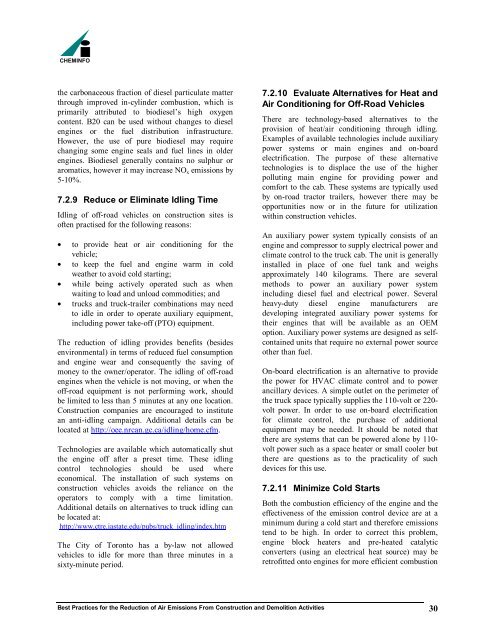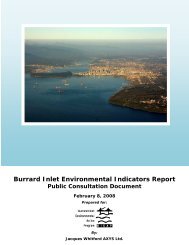Best Practices for the Reduction of Air Emissions From Construction ...
Best Practices for the Reduction of Air Emissions From Construction ...
Best Practices for the Reduction of Air Emissions From Construction ...
Create successful ePaper yourself
Turn your PDF publications into a flip-book with our unique Google optimized e-Paper software.
CHEMINFO<br />
<strong>the</strong> carbonaceous fraction <strong>of</strong> diesel particulate matter<br />
through improved in-cylinder combustion, which is<br />
primarily attributed to biodiesel’s high oxygen<br />
content. B20 can be used without changes to diesel<br />
engines or <strong>the</strong> fuel distribution infrastructure.<br />
However, <strong>the</strong> use <strong>of</strong> pure biodiesel may require<br />
changing some engine seals and fuel lines in older<br />
engines. Biodiesel generally contains no sulphur or<br />
aromatics, however it may increase NOx emissions by<br />
5-10%.<br />
7.2.9 Reduce or Eliminate Idling Time<br />
Idling <strong>of</strong> <strong>of</strong>f-road vehicles on construction sites is<br />
<strong>of</strong>ten practised <strong>for</strong> <strong>the</strong> following reasons:<br />
• to provide heat or air conditioning <strong>for</strong> <strong>the</strong><br />
vehicle;<br />
• to keep <strong>the</strong> fuel and engine warm in cold<br />
wea<strong>the</strong>r to avoid cold starting;<br />
• while being actively operated such as when<br />
waiting to load and unload commodities; and<br />
• trucks and truck-trailer combinations may need<br />
to idle in order to operate auxiliary equipment,<br />
including power take-<strong>of</strong>f (PTO) equipment.<br />
The reduction <strong>of</strong> idling provides benefits (besides<br />
environmental) in terms <strong>of</strong> reduced fuel consumption<br />
and engine wear and consequently <strong>the</strong> saving <strong>of</strong><br />
money to <strong>the</strong> owner/operator. The idling <strong>of</strong> <strong>of</strong>f-road<br />
engines when <strong>the</strong> vehicle is not moving, or when <strong>the</strong><br />
<strong>of</strong>f-road equipment is not per<strong>for</strong>ming work, should<br />
be limited to less than 5 minutes at any one location.<br />
<strong>Construction</strong> companies are encouraged to institute<br />
an anti-idling campaign. Additional details can be<br />
located at http://oee.nrcan.gc.ca/idling/home.cfm.<br />
Technologies are available which automatically shut<br />
<strong>the</strong> engine <strong>of</strong>f after a preset time. These idling<br />
control technologies should be used where<br />
economical. The installation <strong>of</strong> such systems on<br />
construction vehicles avoids <strong>the</strong> reliance on <strong>the</strong><br />
operators to comply with a time limitation.<br />
Additional details on alternatives to truck idling can<br />
be located at:<br />
http://www.ctre.iastate.edu/pubs/truck_idling/index.htm<br />
The City <strong>of</strong> Toronto has a by-law not allowed<br />
vehicles to idle <strong>for</strong> more than three minutes in a<br />
sixty-minute period.<br />
7.2.10 Evaluate Alternatives <strong>for</strong> Heat and<br />
<strong>Air</strong> Conditioning <strong>for</strong> Off-Road Vehicles<br />
There are technology-based alternatives to <strong>the</strong><br />
provision <strong>of</strong> heat/air conditioning through idling.<br />
Examples <strong>of</strong> available technologies include auxiliary<br />
power systems or main engines and on-board<br />
electrification. The purpose <strong>of</strong> <strong>the</strong>se alternative<br />
technologies is to displace <strong>the</strong> use <strong>of</strong> <strong>the</strong> higher<br />
polluting main engine <strong>for</strong> providing power and<br />
com<strong>for</strong>t to <strong>the</strong> cab. These systems are typically used<br />
by on-road tractor trailers, however <strong>the</strong>re may be<br />
opportunities now or in <strong>the</strong> future <strong>for</strong> utilization<br />
within construction vehicles.<br />
An auxiliary power system typically consists <strong>of</strong> an<br />
engine and compressor to supply electrical power and<br />
climate control to <strong>the</strong> truck cab. The unit is generally<br />
installed in place <strong>of</strong> one fuel tank and weighs<br />
approximately 140 kilograms. There are several<br />
methods to power an auxiliary power system<br />
including diesel fuel and electrical power. Several<br />
heavy-duty diesel engine manufacturers are<br />
developing integrated auxiliary power systems <strong>for</strong><br />
<strong>the</strong>ir engines that will be available as an OEM<br />
option. Auxiliary power systems are designed as selfcontained<br />
units that require no external power source<br />
o<strong>the</strong>r than fuel.<br />
On-board electrification is an alternative to provide<br />
<strong>the</strong> power <strong>for</strong> HVAC climate control and to power<br />
ancillary devices. A simple outlet on <strong>the</strong> perimeter <strong>of</strong><br />
<strong>the</strong> truck space typically supplies <strong>the</strong> 110-volt or 220volt<br />
power. In order to use on-board electrification<br />
<strong>for</strong> climate control, <strong>the</strong> purchase <strong>of</strong> additional<br />
equipment may be needed. It should be noted that<br />
<strong>the</strong>re are systems that can be powered alone by 110volt<br />
power such as a space heater or small cooler but<br />
<strong>the</strong>re are questions as to <strong>the</strong> practicality <strong>of</strong> such<br />
devices <strong>for</strong> this use.<br />
7.2.11 Minimize Cold Starts<br />
Both <strong>the</strong> combustion efficiency <strong>of</strong> <strong>the</strong> engine and <strong>the</strong><br />
effectiveness <strong>of</strong> <strong>the</strong> emission control device are at a<br />
minimum during a cold start and <strong>the</strong>re<strong>for</strong>e emissions<br />
tend to be high. In order to correct this problem,<br />
engine block heaters and pre-heated catalytic<br />
converters (using an electrical heat source) may be<br />
retr<strong>of</strong>itted onto engines <strong>for</strong> more efficient combustion<br />
<strong>Best</strong> <strong>Practices</strong> <strong>for</strong> <strong>the</strong> <strong>Reduction</strong> <strong>of</strong> <strong>Air</strong> <strong>Emissions</strong> <strong>From</strong> <strong>Construction</strong> and Demolition Activities 30
















